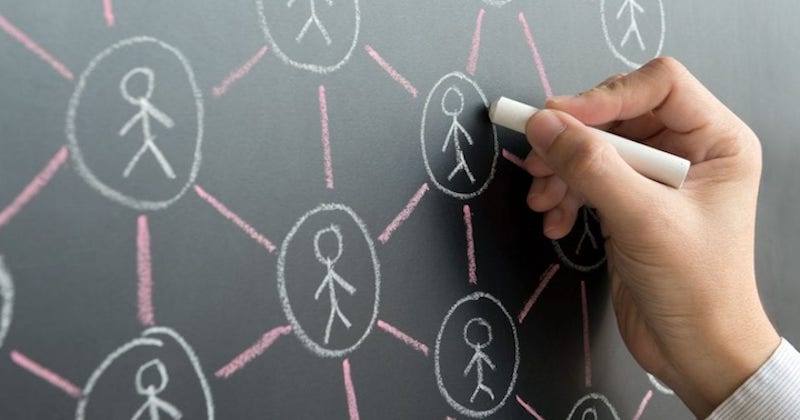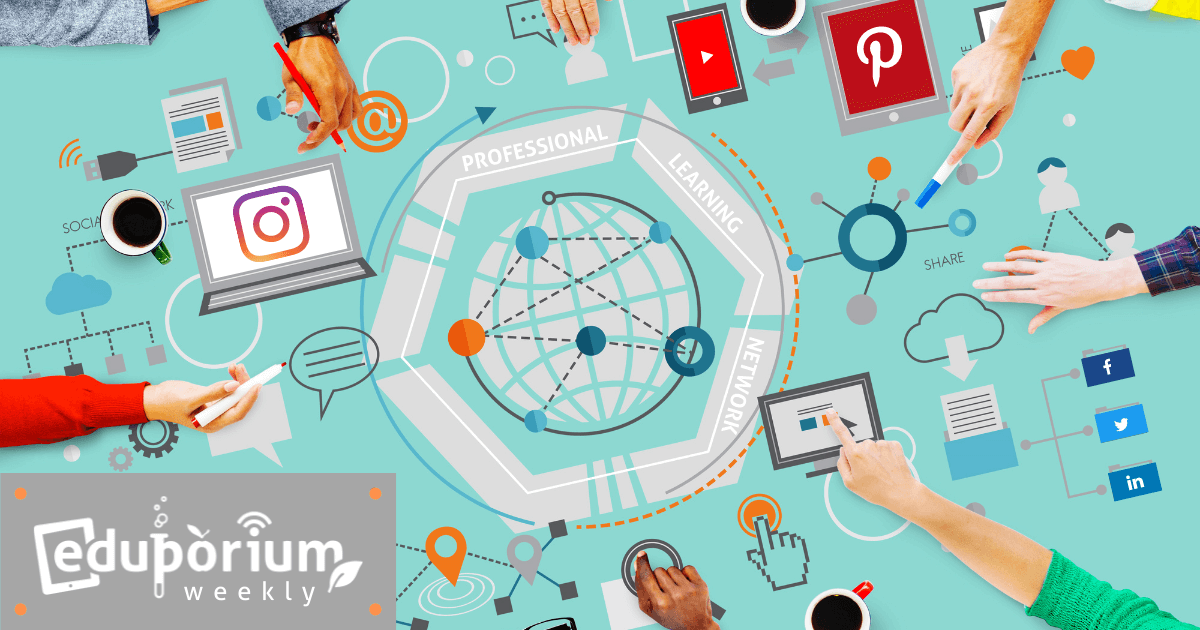The ‘power of the PLN’ is no lie and, especially these days, having an informative, supportive, and helpful online network of colleagues to connect with and turn to not only helps keep teachers sane but can also help many of them navigate today's challenges in the profession. A professional learning network (or PLN) is a group of colleagues or like-minded professionals who communicate and collaborate (usually online) to help maximize each other’s abilities. For teachers, this often means sharing resources, answering requests, and generally offering guidance, support, and encouraging words to each other. Countless educators have created their own PLNs and built relationships with people they’ve never met face to face. And, despite the distance, these can be some of the most valuable partnerships they have.
Understanding What a PLN Is
You might be wondering what exactly constitutes a PLN or how you'd go about building your PLN. As we'd stated in this intro, a PLN is a virtual group of educators who learn, share, and grow together. Much like the term ‘networking’ refers to relationships built in the professional world, K-12 professional learning networks serve as foundations for educators to network, build up their own brands, and find ideas for improving their teaching among other benefits. Various social media websites, including Twitter, Pinterest, Facebook, and Instagram have helped many educators build professional learning networks, but not only build them. With so many resources, educators can completely customize their networks, including people and companies they follow and content they consume. When it comes to PLNs, customization is a pretty big element.
Getting started with a PLN.
PLNs also serve as professional development resources for teachers, putting them completely in charge of their own PD. Educators can often explore their own interests and, more importantly, their own needs as they navigate oceans of useful content. Other PLN benefits include educators getting to connect whenever they'd like and knowing those connections are reliable. Many PLN members are always reachable with the constant digital conversations happening, which allows educators to check in, find content, and contribute their own insights as little or as often as they like. Sharing ideas and receiving feedback will help educators continue this virtual brainstorming process and fine tune their ideas for their classrooms, ultimately leading to improved instruction and, ideally, increased student engagement.
Some of the things you'll learn.
Teachers also typically get to choose the types of learning they'll engage in within their PLNs. Sometimes, they might feel like contributing to general, informal chats to simply connect, vent, or unwind. Other times, chats might involve deeper discussions or debates—something teachers could take part in or avoid. PLNs also help educators stay current on research and instructional practices, often highlighting new ideas to try. Beyond that, when teachers connect with other educators from many different parts of the world, they can share all sorts of new things with their students, including insights into how they, too, can become globally connected. And, above all, building a PLN helps teachers connect with others in ways they can truly enjoy.
Steps to Building a PLN
As we’ve said and, as you may be aware, professional learning networks form almost entirely on social media platforms. For teachers, school administrators, and district leaders, this often means using Twitter. So many teachers utilize Twitter (and Instagram) to connect with both their colleagues and their students (as well as parents). Twitter is perhaps your most valuable tool for providing regular updates as well as for teachers to learn new techniques. Especially these days as things constantly change, Twitter could be a very valuable tool for staying connected. Now that we're back to more normal times, teachers continue to use the website to find others (either from their school or from all over the country) who are looking for the same solutions or those who can offer answers to their questions.
Using social media to boost knowledge.
Step 1 to building any PLN is exploring social media sites to boost your access to educational resources. You don’t have to build your entire network overnight, so don’t worry about going for quantity. You'll want quality and it’s perfectly okay that building your ideal network will take some time. To find the connections that are most useful for you, you can use Twitter to discover unlimited useful blog posts, webinars, email newsletters, podcasts, videos, forums, and people who are relevant to you. Then, it’s as simple as sharing your thoughts, interacting with others, and learning new things. Tagging someone who you’re basing your own thoughts off of or replying to a post you agree with (or disagree with) is a great method for getting all your thoughts in front of more people and a good first step to building your own PLN.
Creating and organizing content.
With so much content, it can be tough, especially for anyone new to this, to keep track of everything. Using curation tools when reading, editorializing, and sharing educational content is one strategy. Following some certain hashtags on Twitter that you find interesting is another. This could help you discover lots of relevant content and experts in any field. Plus, using annotation tools can help you find any useful quotes, connect with those who share similar views, and summarize what you read. Finally, sharing content that’s yours (or somebody else’s) is easy. You can also write original blog posts about your teaching goals and objectives, philosophies, challenges, or thoughts, share that post to your social media channels, and host all of your thoughts in multiple places—both on your social profile and on your own blog as you build your network.

How PLNs Can Help Teachers
Educators could start building and adding to PLNs at any time—one reason why they're never really fully completed. PLNs serve as both professional learning spaces and personal learning spaces for educators since they could apply almost everything they learn to their jobs, but what they learn also aligns with their needs and interests. As educators utilize their own PLN, they can, in turn, become a source of information for other educators. These educators might also be looking for inspiration on social media sites and within their own school or district. Spending just a little time each day navigating thoughts others have shared in the PLN can help teachers self-reflect. Also, in the long run, leveraging a professional learning network can help educators stay current, recognize good ideas, and learn strategies for enriching instruction.
Other benefits of PLNs for teachers.
In most professional learning networks for teachers, members are unofficially ‘accepted’ based on ideas they share rather than their titles, which is super important to many. Nobody needs a high-ranking title or administrative authority to develop wise perceptions of what works well for educating today’s children. In fact, many teachers would argue that nothing can replace classroom experience in determining what may serve students best. A PLN is a constantly developing outlet—not a quick outcome of formal professional development experiences or a workshop. It’s a source of long-term, constantly evolving, and immediately applicable PD that will probably never solve a specific problem overnight. With some exploring, however, teachers can gain valuable insights and build greater digital literacy skills for themselves in the process.
Tailoring a PLN to benefit you.
Professional learning networks can intrinsically foster an authentic aura of collaboration—a specific kind of bonding that may be missing among some teachers. Since face-to-face conversations are typically limited to peers in their school, there aren’t always fresh ideas. By making new connections in their PLN, however, they could learn about entirely new tactics for using their own skill sets to reach today’s students. Teachers try so many different approaches and it would truly take any one teacher forever to try them all. This comes back to generating a PLN that’s geared toward your strengths, interests, and professional needs. Once you feel like you've done this, collaborative brainstorming and implementation often take over.
How Teachers Benefit From PLNs
PLNs often begin online but that doesn’t mean learning opportunities are limited only to virtual interactions. We hear stories of educators interacting online, sharing ideas for a while, and eventually meeting up face to face at conferences. While this does not exactly happen all the time, it certainly does speak to the power of professional learning networks. Besides making some new sets of friends with similar interests, challenges, and ideas, finding a PLN provides a lot of benefits for teachers. Using a PLN, it’s easy for them to discover new resources, lesson plan ideas, and even events they’d like to attend—all of which is information they can bring back to their principal or superintendent and, hopefully, get the green light to proceed.
Who to follow to start your PLN.
We’d argue that getting started with a PLN might be the easiest part as well as the most exciting phase. If you’re using Twitter, particularly, you’ll see how many amazing educators share their ideas for followers all around the world. Following these educators allows you to build your knowledge base and, of course, find and share their content. If you’re looking for some to follow, we’d recommend Alice Keeler, Tim Tomaso, Joe Sanfelippo, Tom Murray, Eric Sheninger, Tony Sinanis, Jorge Valenzuela, and Todd Nesloney as just a few off the top of my head. Once connected with as many people as you want (it’s fine if they don’t follow back), you can start sharing their resources on your page as well as any you create on your own.
The possibilities of PLNs.
In addition to the more obvious benefits of PLNs, they could also help classroom educators in unique and subtle ways. Educators can find quick answers to specific questions and support when they need it. They can even make international connections in a lot of cases and discover some totally new perspectives. Or, they can connect live with other teachers to extend the reach of their classroom immensely. Collaborating globally is a fantastic experience for both instructors and students and one that PLNs help make possible. Other benefits include finding around-the-clock inspiration, discovering relevant hashtags, and accessing an endless stream of new ideas for the classroom.

More Ways to Use Your PLN
Though the reasons educators use PLNs tend to be for bettering themselves, there are many specific ways to maximize them. If a teacher has a new role, for example, (something which happens a lot) or they simply want to learn about some new ways to use technology in their classrooms, a PLN can be a great source of information. There are various formal and informal educator groups you could join and each one provides value in different ways. Sharing in PLNs is constant and immediate, so teachers who pose questions often find a potential solution within hours. From science to music and history to PE, their digital worlds contain answers contemporary educators are often seeking.
Getting answers from the PLN.
When teachers need help from fellow teachers, collaboration within PLNs is very easy to find. Whether you want a quick answer to a long-posed question, an in-depth explanation of any opinion, or you’re looking to find someone to work with on a new project, chances are you can find it. In fact, many educators often find answers before they even officially pose their questions. Then, there’s the sharing side of things. Educators routinely find themselves looking for lesson and content ideas on some fairly specific topics, like classroom robotics, for example. Asking your PLN members for input can yield some quick results and, quite possibly, exactly what you’re looking for (even if you don’t yet know what exactly you’re seeking).
Time to get started.
PLNs even provide teachers with opportunities to find speakers or presenters for school events or to lead virtual PD. It’s definitely possible to find somebody who would be willing to spend an hour or so leading a virtual discussion on a wide range of education topics. Also, PLNs help educators personalize professional learning in addition to the school-sponsored PD. Knowing what you like and what you need could help you find and adopt resources from your PLN. And, finally, educators should use PLNs to support and challenge their perspectives on various viewpoints. Seeing how educators from different parts of the world—from the inner city to the incredibly rural—approach problem solving can be very enlightening. So, we hope this may help inspire some action and we’d love to have you find, join, or start a PLN.
For the latest EdTech, STEM, and 21st century education news, follow us on Twitter and Instagram. Like us on Facebook, too, or sign up for our newsletter for our latest product announcements and offerings. If you have an idea for an Eduporium Weekly theme, send us a message on social media or comment below.



